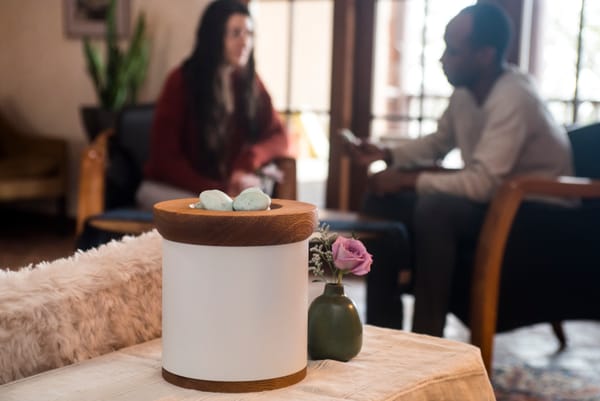Memorial Options After Sudden Death: A Sensitive Guide
When loss is unexpected, choosing a memorial can feel impossible. This sensitive guide offers supportive options to help families find comfort and connection after sudden death.

Memorial needs differ significantly between sudden and expected deaths. Sudden loss requires lower-decision fatigue options, flexible timelines, and support for trauma processing, while expected death allows for planning and anticipatory grief processing.
When death arrives without warning, families often find themselves navigating uncharted emotional territory while simultaneously facing immediate decisions about honoring their loved one. The disorientation that follows sudden loss creates unique challenges that differ markedly from situations where death was anticipated.
Many families discover that traditional memorial planning approaches—designed around advance notice and gradual acceptance—don't align with the acute grief experience. Understanding these differences and exploring memorial options suited to sudden death can provide both comfort and practical guidance during an overwhelming time, helping you find meaningful ways to honor your loved one while processing this unexpected loss.
Reflections on love, loss, and the ways we carry them.
I once spoke with a mother who lost her son in an accident. She said the hardest part wasn’t just the silence that followed, but the decisions she had to make while still in shock. “People kept asking about the service, the urn, the burial,” she told me. “All I wanted was a little more time to breathe.” This is what grief experts call cognitive overload: when the mind, already stunned by loss, is asked to make choices it isn’t ready for.
Sudden loss brings its own rhythm of mourning. While expected death allows space for preparation, sudden death demands gentleness with timing. Families in shock don’t need quick decisions; they need options that can wait for when the heart catches up. That’s why flexible memorial approaches matter so deeply.
When families choose solidified remains, many say it feels like a weight lifts. In 8 to 10 weeks, the vast majority of ashes are transformed into smooth, stone-like forms. Something tangible that they can hold, share, or keep close without the pressure of making every decision right away. It becomes a quiet companion during those first raw months, when plans can feel too heavy and permanence too soon.
Over time, these stones often evolve into part of larger memorials such as a garden, a ceremony, a place of light. Grief, like love, shifts and softens. What remains is something steady in your hands, reminding you that it’s okay to take your time, to move at the pace of your own healing, and to honor your loved one in your own way.
Cathy Sanchez Babao
Parting Stone Grief Coach
Immediate Memorial Solutions
For families experiencing sudden loss, immediate memorial solutions focus on providing comfort and connection without requiring extensive planning or decision-making. Simple memorial approaches that can be implemented quickly include creating memory tables with photographs and personal items, organizing informal gatherings where people can share stories, and establishing temporary memorial spaces that can evolve.
Digital memorial options often work well for sudden loss situations because they require minimal upfront planning while allowing for ongoing contributions from extended family and friends. Online monument pages, social media tributes, and collaborative photo collections enable grieving families to begin the memorial process without committing to permanent decisions they might later regret.
Many families also find comfort in immediate, tangible memorial options that provide physical connection during early grief processing. These might include memorial jewelry, custom artwork incorporating personal elements, or memorial garden spaces that can be developed gradually as emotional clarity returns.
Flexible Timeline Options
Memorials that accommodate changing needs over time prove especially valuable in situations involving sudden loss. Multi-phase memorial planning allows families to begin with simple, immediate tributes while planning more comprehensive celebrations as they process their grief and gather input from their broader community.
Delayed memorial services—held weeks or months after the death—often work better for sudden loss families than immediate services. This approach allows time for shock to subside, for distant relatives and friends to make travel arrangements, and for families to plan celebrations that genuinely reflect their loved one's life rather than responding to immediate pressures.
Some families choose to combine immediate private gatherings with later public celebrations, creating space for intimate grief processing while still honoring the deceased person's broader community connections. This approach acknowledges that different people may be ready for celebration and remembrance at other times.

Practical Steps for Memorial Planning
When navigating memorial planning after a sudden loss, breaking decisions into manageable categories can prevent overwhelming feelings while ensuring important choices receive appropriate attention. The key lies in identifying which decisions require immediate attention and which can be deferred until emotional processing allows for clearer thinking.
Essential Decisions First
Focus initially on decisions that have genuine time constraints, such as legal requirements for death certificates, immediate needs for body care or cremation, and any religious or cultural observances that must occur within specific timeframes. Most other memorial decisions—including service format, guest lists, and celebration details—can be postponed until you feel more emotionally equipped to make thoughtful choices.
Many families benefit from appointing a trusted friend or family member to handle logistical coordination during the immediate period. This person can field calls from well-meaning relatives asking about memorial plans, research options for later consideration, and help protect the immediate family's need for time to process their loss.
For families choosing cremation, new options like solidified remains, offered through services such as Parting Stone's solidification process, can provide a tangible connection that feels more comforting than traditional ashes. The process transforms cremated remains into smooth, stone-like forms that can be held, shared among family members, or incorporated into memorial gardens, providing physical comfort during difficult periods of grieving.
Support System Integration
Sudden loss often reveals the importance of accepting help while maintaining boundaries around decision-making. Extended family and friends frequently want to contribute to memorial planning, but their emotional state may differ significantly from that of immediate family members. Creating structured ways for others to help—such as coordinating food, managing communications, or researching memorial options—can provide valuable support without overwhelming grieving family members with additional decisions.
Consider appointing different people to handle various aspects of memorial coordination. Someone might manage communications with extended family, another might research venue options, and a third might coordinate with religious or spiritual advisors. This approach distributes the workload while maintaining family control over major decisions.
Professional support often proves invaluable during the planning of sudden loss memorials. Grief counselors who specialize in acute grief can provide guidance on timing decisions, while experienced funeral directors can present options without pressure and accommodate families' needs for processing time.
Long-term Memorial Evolution
Memorial needs often evolve significantly in the months and years following sudden loss. What feels appropriate during initial shock may not align with long-term remembrance preferences, making flexibility a crucial consideration in early memorial planning. Understanding this evolution can help families make initial choices that support rather than constrain their ongoing grief process.
Many families find that their capacity for celebration and public remembrance increases over time. Initial private memorials may later expand into annual gatherings, scholarship funds, or community service projects that honor the deceased person's values and interests. Allowing for this evolution prevents families from feeling locked into memorial approaches that no longer serve their needs.
Physical memorial elements often require adjustment over time as well. Initial memorial gardens may be expanded, memorial jewelry might be redesigned to incorporate additional family members, or memorial displays might be relocated to better accommodate changing living situations. Some families choose memorial options that can evolve—such as solidified remains that can be divided among family members or combined with memorial gardens as circumstances change.
The long-term memorialization process also encompasses how families choose to integrate remembrance into their ongoing life rhythms. Annual memorial traditions, birthday celebrations, or holiday observances often develop organically as families discover what feels meaningful and sustainable for their particular situation.
How Sudden Loss Affects Memorial Planning
The neurological and emotional impact of sudden death creates a distinct grief experience that researchers call acute grief, fundamentally different from anticipatory grief that occurs before an expected death. According to studies published in the Journal of Traumatic Stress, sudden death grief often includes elements of trauma processing, making decision-making more challenging during the immediate aftermath.
The Shock Factor in Decision Making
When death occurs suddenly, families typically experience what grief counselors term "cognitive overload"—the brain's struggle to process both the emotional reality and practical demands simultaneously. This state often manifests as difficulty concentrating, memory issues, and feeling overwhelmed by choices that might usually seem manageable. Many families find themselves unable to make complex decisions about memorial services, burial preferences, or celebration-of-life planning in the first days following their loss.
The shock factor also affects how families process information about memorial options. Traditional funeral planning conversations, which assume emotional readiness and time for consideration, can feel inappropriate or even harmful when someone is still struggling to accept the reality of their loss.
Timeline Pressures vs Processing Needs
Sudden death creates an immediate tension between external pressures for quick decisions and internal needs for time to process. Funeral homes, cemeteries, and memorial venues often operate on standard timelines that don't account for acute grief states. Meanwhile, families dealing with sudden loss frequently need more time to understand their emotional needs and gather input from extended family and friends who are equally shocked.
This timeline mismatch can lead to memorial decisions that feel rushed or don't truly reflect the deceased person's life or the family's values. Understanding this dynamic can help families advocate for the time they need or seek memorial approaches that allow for flexibility and evolution over time.
Memorial Approaches for Different Grief Types
The type of grief experience significantly influences which memorial approaches will feel most supportive and meaningful. Recognizing these differences can guide families toward options that align with their current emotional state and practical capabilities.
| Consideration | Sudden Death | Expected Death |
|---|---|---|
| Decision Timeline | Delayed processing preferred | Advance planning possible |
| Support Availability | Crisis-response networks | Established care teams |
| Emotional State | Shock and disorientation | Gradual acceptance process |
| Planning Capacity | Reduced cognitive function | Time for thoughtful choices |
| Memorial Urgency | Flexible timing beneficial | Traditional schedules workable |
Immediate Memorial Solutions
For families experiencing sudden loss, immediate memorial solutions focus on providing comfort and connection without requiring extensive planning or decision-making. Simple memorial approaches that can be implemented quickly include creating memory tables with photographs and personal items, organizing informal gatherings where people can share stories, and establishing temporary memorial spaces that can evolve.
Digital memorial options often work well for sudden loss situations because they require minimal upfront planning while allowing for ongoing contributions from extended family and friends. Online monument pages, social media tributes, and collaborative photo collections enable grieving families to begin the memorial process without committing to permanent decisions they might later regret.
Many families also find comfort in immediate, tangible memorial options that provide physical connection during early grief processing. These might include memorial jewelry, custom artwork incorporating personal elements, or memorial garden spaces that can be developed gradually as emotional clarity returns.
Flexible Timeline Options
Memorials that accommodate changing needs over time prove especially valuable in situations involving sudden loss. Multi-phase memorial planning allows families to begin with simple, immediate tributes while planning more comprehensive celebrations as they process their grief and gather input from their broader community.
Delayed memorial services—held weeks or months after the death—often work better for sudden loss families than immediate services. This approach allows time for shock to subside, for distant relatives and friends to make travel arrangements, and for families to plan celebrations that genuinely reflect their loved one's life rather than responding to immediate pressures.
Some families choose to combine immediate private gatherings with later public celebrations, creating space for intimate grief processing while still honoring the deceased person's broader community connections. This approach acknowledges that different people may be ready for celebration and remembrance at other times.
Practical Steps for Memorial Planning
When navigating memorial planning after a sudden loss, breaking down decisions into manageable categories can help prevent overwhelming feelings while ensuring that essential choices receive the appropriate attention. The key lies in identifying which decisions require immediate attention and which can be deferred until emotional processing allows for clearer thinking.
Essential Decisions First
Focus initially on decisions that have genuine time constraints, such as legal requirements for death certificates, immediate needs for body care or cremation, and any religious or cultural observances that must occur within specific timeframes. Most other memorial decisions—including service format, guest lists, and celebration details—can be postponed until you feel more emotionally equipped to make thoughtful choices.
Many families benefit from appointing a trusted friend or family member to handle logistical coordination during the immediate period. This person can field calls from well-meaning relatives asking about memorial plans, research options for later consideration, and help protect the immediate family's need for time to process.
For families choosing cremation, new options like solidified remains, offered through services such as Parting Stone's solidification process, can provide a tangible connection that feels more comforting than traditional ashes. The process transforms cremated remains into smooth, stone-like forms that can be held, shared among family members, or incorporated into memorial gardens, providing physical comfort during difficult periods of grieving.
Support System Integration
Sudden loss often reveals the importance of accepting help while maintaining boundaries around decision-making. Extended family and friends frequently want to contribute to memorial planning, but their emotional state may differ significantly from that of immediate family members. Creating structured ways for others to help—such as coordinating food, managing communications, or researching memorial options—can provide valuable support without overwhelming grieving family members with additional decisions.
Consider appointing different people to handle various aspects of memorial coordination. Someone might manage communications with extended family, another might research venue options, and a third might coordinate with religious or spiritual advisors. This approach distributes the workload while maintaining family control over major decisions.
Professional support often proves invaluable during the planning of sudden loss memorials. Grief counselors who specialize in acute grief can provide guidance on timing decisions, while experienced funeral directors can present options without pressure and accommodate families' needs for processing time.
Long-term Memorial Evolution
Memorial needs often evolve significantly in the months and years following a sudden loss. What feels appropriate during initial shock may not align with long-term remembrance preferences, making flexibility a crucial consideration in early memorial planning. Understanding this evolution can help families make initial choices that support rather than constrain their ongoing grief process.
Many families find that their capacity for celebration and public remembrance increases over time. Initial private memorials may later expand into annual gatherings, scholarship funds, or community service projects that honor the deceased person's values and interests. Allowing for this evolution prevents families from feeling locked into memorial approaches that no longer serve their needs.
Physical memorial elements often require adjustment over time as well. Initial memorial gardens may be expanded, memorial jewelry might be redesigned to incorporate additional family members, or memorial displays might be relocated to better accommodate changing living situations. Some families choose memorial options that can evolve—such as solidified remains that can be divided among family members or combined with memorial gardens as circumstances change.
The long-term memorialization process also encompasses how families choose to integrate remembrance into their ongoing life rhythms. Annual memorial traditions, birthday celebrations, or holiday observances often develop organically as families discover what feels meaningful and sustainable for their particular situation.
Finding Peace in Remembrance
Memorial planning after a sudden loss requires patience with yourself and recognition that no single approach will address every emotional need. The goal isn't to achieve perfect memorial decisions, but rather to create space for honoring your loved one while supporting your own grief processing. Remember that meaningful remembrance can take many forms and may change as your understanding of your loss deepens.
Professional support through grief counselors, especially those trained in acute grief and trauma processing, can provide valuable guidance as you navigate both immediate memorial decisions and long-term remembrance planning. The National Alliance on Mental Illness (NAMI) offers resources for finding qualified grief support professionals in your area.
Every family's memorial needs are unique, shaped by cultural background, religious beliefs, financial circumstances, and personal preferences. Trust your instincts about what feels right for your situation, even if it differs from others' expectations or traditional approaches. Your loved one's memory deserves to be honored in ways that bring comfort and meaning to those who continue to cherish their love.
You're Not Alone in This Journey
Many families find that traditional ashes create more anxiety than comfort—whether it's difficulty with storage, challenges sharing among family members, or simply feeling uncomfortable with the form they're in. Over 10,000 families have found peace through Parting Stone's solidification process, which transforms ashes into smooth, natural stones that feel comforting to hold and easy to share.
When you're ready to explore options:
There's no timeline for grief, and there's no rush to make decisions. We're here to support you whenever you feel ready to take the next step.







